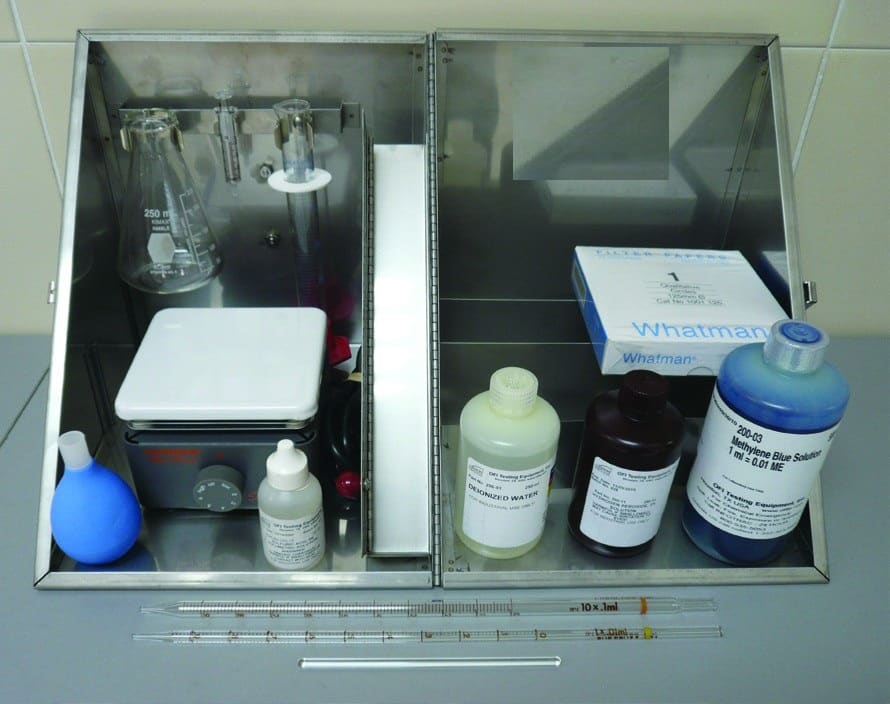Cation Exchange Capacity In Mud System
This Methylene Blue Test Clay Content in drilling mud is used for measuring the Cation Exchange Capacity (CEC), which determines the reactive clays in the mud system. This article is one of the water-based drilling fluid testing procedures articles that handle the chemical testing of WBM.
Equipment For Methylene Blue Test Clay Content In Drilling Mud

The test requires the following equipment:
- 250 ml glass conical flask
- A 2 ml or 5 ml syringe
- 50 ml graduated burette or 10 ml graduated pipette
- 50 ml graduated measuring cylinder
- Glass stirring rod
- Hot Plate
- Whatman Filter Paper #1
- Methylene Blue solution
- Hydrogen Peroxide (3 % solution)
- Sulfuric Acid (5N solution)
The methylene blue test drilling mud Test Procedures
The procedure for performing the Methylene Blue Test in drilling mud is as follows:
- The syringe transfers a 2 ml mud sample into the glass conical flask containing 10 ml distilled water.
- Use the graduated measuring cylinder to add 15 ml of 3% Hydrogen Peroxide (H2O2 ) to the conical flask, and add 0.5 ml of 5N Sulfuric Acid using
a dropper bottle and mix thoroughly by shaking the conical flask. - Place the conical flask on the hot plate and boil gently for 10 minutes without boiling dry (The Hydrogen Peroxide is designed to remove the
effects of organic materials in the drilling fluid that absorb methylene blue, ensuring that the test only determines reactive clay content). - After boiling, remove the conical flask from the hot plate and bring the total suspension volume in the conical flask to about 50 ml with distilled water.
- Add 0.5 ml Methylene Blue to the conical flask using the burette or pipette and stir thoroughly for several seconds.
- Shake the conical flask and use the glass rod to transfer a drop of fluid from the conical flask onto a piece of Whatman Filter Paper #1 and check for the appearance of a “blue halo” on the edge of the blue circle.
- If no halo appears, then add another 0.5 ml of Methylene Blue to the conical flask and repeat Steps 5 and 6 until a “blue halo” appears, keeping a record of the total amount of Methylene Blue added.
- When a “blue halo” appears, repeat Step 6 after two minutes to check that the “blue halo” is still present, confirming the endpoint of the titration.
- The methylene blue test results are reported as Methylene Blue Capacity (MBC) or as Bentonite Equivalent (lb/bbl). See Figure 10 below.
MBC = [ml of Methylene Blue] / [ml of Mud Sample]
Bentonite Equivalent (ppb) = 5 x [ml of Methylene Blue] / [ml of Mud Sample]
Methylene Blue Test For Shale Samples
The procedure for measuring the Cation Exchange Capacity of shale samples (check also: shale inhibitors article) follows a similar format as that for mud and requires the following equipment:
- 150 ml glass conical flask
- Graduated pipette
- Glass stirring rod
- Hot Plate
- Whatman Filter Paper #1
- De-Ionized water
- Methylene Blue solution
- Sulfuric Acid (5N solution)
The following procedure is used for measuring the CEC of a shale sample:
- Accurately weigh around 1 gram of dried ground shale sample.
- Place the shale sample in the glass conical flask containing 50 ml de-ionized water.
- Add 0.5 ml 5N sulfuric acid.
- Place on the hot plate and boil gently for 10 minutes.
- Remove from the hot plate and leave to cool down.
- Add 0.5 ml Methylene Blue to the conical flask using the burette or pipette and stir thoroughly for several seconds.
- Shake the conical flask and use the glass rod to transfer a drop of fluid from the conical flask onto a piece of Whatman Filter Paper #1 and check
for the appearance of a “blue halo” on the edge of the blue circle. - If no halo appears, add another 0.5 ml Methylene Blue to the conical flask and repeat Steps 6 and 7 until a “blue halo” appears, keeping a record of the total amount of Methylene Blue added.
- When a “blue halo” appears, repeat Step 7 after two minutes to check that the “blue halo” is still present, confirming the endpoint of the titration.
- The CEC of the Shale, expressed in milliequivalent per 100 gm, is calculated.
Calculation for determining the Cation Exchange Capacity of a shale sample.
CEC (meq/100gm) = Methylene Blue (ml) / Weigh of Shale Sample (gram)
I have experience in drilling 14year onshore and I hope to work with your company
we are not a company. We are moderating an educational website
This procedure is perfectly drafted, thanks!
Thanks, please follow my blog to get updated educational articles.